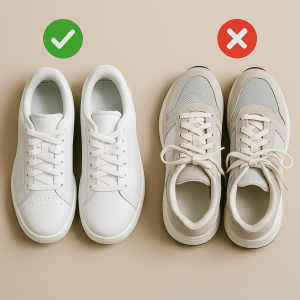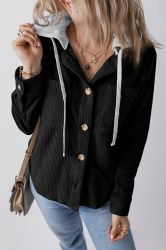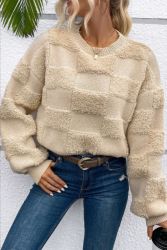Date: 26 Jul 2025
In fashion, shoes are not just an accessory – they’re the foundation of both style and comfort. A well‑thought‑out choice can serve you faithfully for years, while a hasty purchase often leads to disappointment and wasted money.
Below you’ll find in detail the most common mistakes people make when buying shoes and how to avoid them, so you can make a choice that truly pays off.
1. Materials – what’s right and what’s wrong
Right:
Shoes should be made from materials that “work” with your feet. Genuine leather, for example, breathes, adapts to the shape of the foot, and becomes even more comfortable over time. High‑quality textiles and modern engineered materials can also allow airflow and flexibility.
Wrong:
Many people get tempted by the look and buy shoes made of cheap synthetic leather. At first they look fine, but after a few months they crack, trap moisture, and feel uncomfortable. Worse, they don’t let your feet breathe, which leads to sweating and odor.
How to apply:
When buying, feel the surface and inspect it closely. Look for labels like “100% leather” or similar guarantees. For textile shoes, check if the fabric is dense yet flexible and if the sole is well attached.
2. Construction – small details speak volumes
Right:
Quality shoes always have neat stitching – straight, even, with no loose threads. The sole is firmly fixed, and edges are smooth and finished. Even inside, there are no rough seams that could hurt your feet.
Wrong:
In cheaper models you’ll often see glued soles without additional stitching. One heavy rain or flex and the glue gives out. Stitches may be uneven, with random thread ends. Even small defects like uneven edges are signs the shoes won’t last.
How to apply:
Hold the shoe in your hands, look at it from all angles, and gently flex the sole. Check how firmly the upper is joined to the sole. Look inside – good craftsmanship shows there too.
3. Design and models – think long term
Right:
Choose shoes that easily match your wardrobe. Classic colors like black, brown, beige, or navy always work. Timeless models like elegant oxfords, well‑made loafers, or sturdy ankle boots can be worn for years without looking out of date.
Wrong:
Chasing fast trends often leads to shoes you wear once or twice. It’s fine to have one such pair for fun, but if you want durability, avoid extreme styles that are hard to match and quickly lose appeal.
How to apply:
Before buying, ask yourself: “Can I wear these with at least 5 different outfits?” If the answer is no, they’re probably not a smart choice.
4. Care and maintenance – shoes need attention
Right:
Quality shoes will serve you longer if you take care of them. Regular cleaning, using leather creams or protective sprays, prolongs their life. After wet weather, let them dry naturally and fill them with paper to maintain shape.
Wrong:
Storing shoes dirty or wet is a sure way to ruin them. Skipping protective treatments – especially for leather – leads to cracking and loss of shape.
How to apply:
Get yourself a basic care kit – a brush, cream, and a protective spray. Spend a few minutes after wearing them to clean and condition. Even premium shoes will look new for years with this routine.
5. Comfort – the right size and shape
Right:
The best shoes fit perfectly from the first try. Your toes should have enough room without sliding around. The heel should not lift as you walk, and the shoe should support your foot securely.
Wrong:
“They’ll stretch” is one of the worst excuses. Shoes that are too tight cause blisters and foot problems. Too loose and you get instability and pain. Even the most expensive pair isn’t worth it if it doesn’t fit properly.
How to apply:
Measure your feet (length and width) and compare them with the manufacturer’s size chart. Try shoes on in the late afternoon when feet are slightly swollen – that’s how you know if they’ll still be comfortable after a long day.
6. Think investment, not impulse
Right:
When choosing shoes, think of them as part of your wardrobe for years ahead. Even if you pay a little more, it’s better than buying three cheap pairs that wear out quickly. Quality shoes pay for themselves over time.
Wrong:
Impulse buying “because they’re cheap” often leads to closets full of shoes you never wear. In the end, you spend more, not less.
How to apply:
Make a list of the shoe types you actually use. Invest in a solid, well‑made model for each category. That’s a smart step toward a more curated and functional wardrobe.
Summary
Choosing shoes should never be a compromise. The right shoes:
-
are made from quality materials,
-
have solid construction and clean stitching,
-
come in classic models that pair easily,
-
get proper care,
-
and fit perfectly from day one.
Follow these principles and every purchase becomes worthwhile – your shoes will look and feel great for years.







